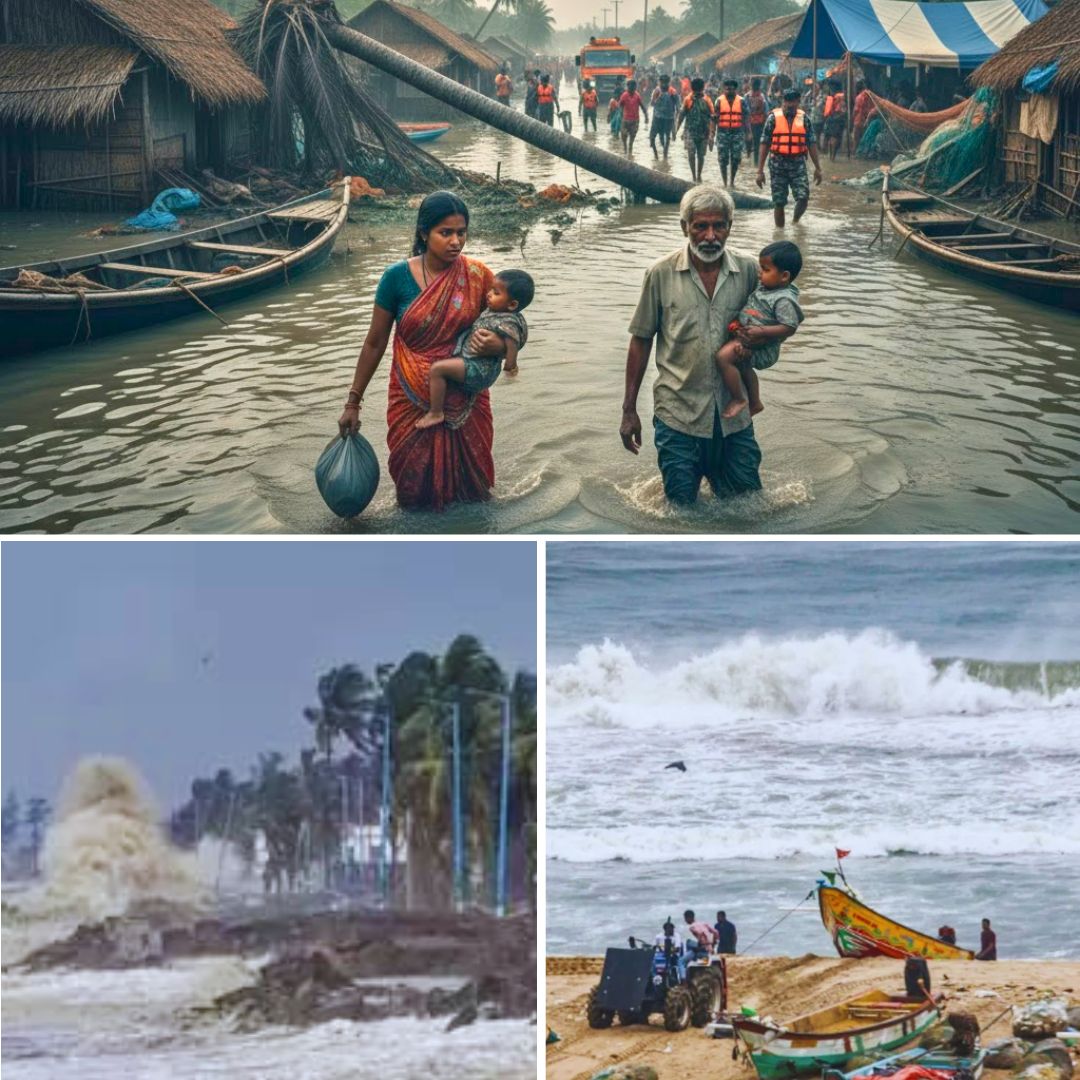Severe cyclonic storm Montha carved a furious path across Andhra Pradesh’s eastern coastline on October 28, 2025, marking one of the most intense weather events in recent memory.
Making landfall between the towns of Machilipatnam and Kalingapatnam near Kakinada around 7 PM, the cyclone brought with it sustained winds of 90 to 100 km/h, gusting up to 110 km/h, and torrential rains that triggered significant flooding and widespread damage.
In this comprehensive report, The Logical Indian delves into the cyclone’s impact, the government’s relief efforts, and the enduring call for community resilience in the face of increasing climate threats.
Cyclone Montha’s Impact: Damage and Displacement
The storm’s fury was immediately apparent as uprooted trees littered streets, electric poles snapped under the strain, and waves surged up to 10 feet high, inundating coastal villages along Andhra Pradesh’s East Godavari and Krishna districts. The village of Rajolu on the Konaseema coast witnessed severe flooding due to tidal waves surging inland, forcing many households to relocate temporarily to relief centres.
The India Meteorological Department (IMD) reported that Montha dropped extremely heavy rainfall, particularly in Nellore district, where water levels swelled dramatically. According to officials, the cyclone damaged approximately 43,000 hectares of crops across the state, including 38,000 hectares of standing farmland and vast tracts of horticulture farmland.
The agricultural loss poses a significant concern for the largely agrarian communities dependent on these harvests for livelihood.
The human toll, thankfully, remains relatively low given the storm’s severity, with one confirmed fatality reported in Konaseema district. Precautionary evacuations and efficient disaster response contributed to minimising injuries and loss of life. Over 76,000 people were relocated from vulnerable coastal and low-lying areas to more than 800 relief camps established by state authorities.
Pregnant women and other high-risk individuals received prioritized attention, with arrangements made for their safe accommodation and medical care.
Government Response and Restoration Efforts
Ahead of the cyclone’s arrival, authorities issued red alerts across 19 coastal districts, prompting widespread school closures and transport suspensions in affected areas including Visakhapatnam, Vijayawada, and Machilipatnam.
The Andhra Pradesh Disaster Management Authority, alongside National Disaster Response Force (NDRF) and State Disaster Response Force (SDRF) teams, mobilised rapidly, deploying over 22 rescue teams and hundreds of support personnel to ensure swift evacuation and relief distribution.
Parliamentary representative and Chief Minister N. Chandrababu Naidu conducted on-ground assessments post-landfall, assuring citizens that restoration operations were underway with special focus on reinstating power after widespread outages.
To address immediate needs, 219 medical camps were set up and essential supplies like food, water, and tarpaulins were distributed amongst displaced families.
Electricians numbering around 1,000, complemented by 140 rescue swimmers, were engaged in restoring connectivity and responding to emergency calls across affected districts. Road clearances began promptly in places like Guntur where trees blocked transportation routes, and railway officials started repair work on tracks impacted by landslides in Araku Valley.
Beyond Andhra Pradesh, neighbouring states such as Odisha and Telangana reported lighter damage due to Cyclone Montha. Odisha evacuated nearly 18,000 residents and experienced minor landslides with no casualties, while areas in Telangana saw heavy rains and flooding in districts like Rangareddy, carrying coastal storms further inland.
Background and Broader Context
Cyclone Montha originated as a deep depression over the Bay of Bengal and quickly intensified into a severe cyclonic storm, moving north-northwestwards toward India’s eastern coast. The India Meteorological Department predicted that Montha would maintain significant strength for approximately six hours post-landfall, resulting in intense weather conditions not only on the coast but also over interior districts prone to flash floods and landslides.
The response this year demonstrates improved preparedness when compared to past cyclone events, with early warnings and evacuations reducing the human toll. However, the large-scale agricultural damage and infrastructural disruptions highlight persistent vulnerabilities faced by coastal communities.
These events echo broader climate change concerns, as rising sea temperatures and erratic monsoon patterns increase the frequency and intensity of storms affecting the Bay of Bengal rim.
The Logical Indian’s Perspective
Cyclone Montha’s strike serves as a stark reminder of the escalating climatic challenges confronting India’s coastlines. While it is encouraging to see government agencies and community volunteers work cohesively to mitigate the impact, more comprehensive strategies are urgently needed.
The Logical Indian advocates for investment in resilient infrastructure, including cyclone-resistant housing and sustainable coastal protection measures, alongside robust early warning systems accessible to remote populations.
Most critically, this disaster underlines the need for empathy-driven policy that supports vulnerable agricultural communities in recovering from sudden losses and transitioning towards climate-adaptive livelihoods. The courage exhibited by first responders, relief workers, and citizens themselves reflects the enduring strength of human solidarity when facing adversity.












